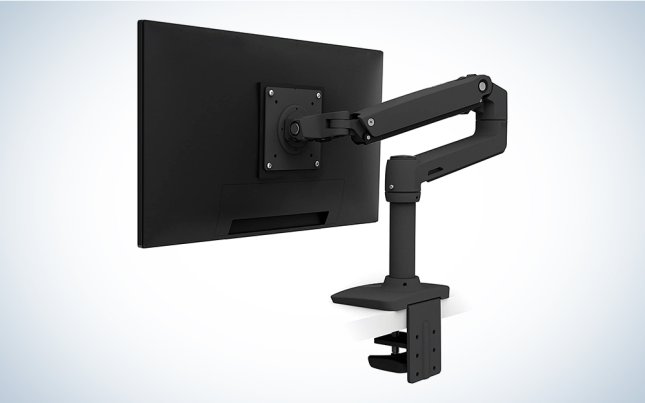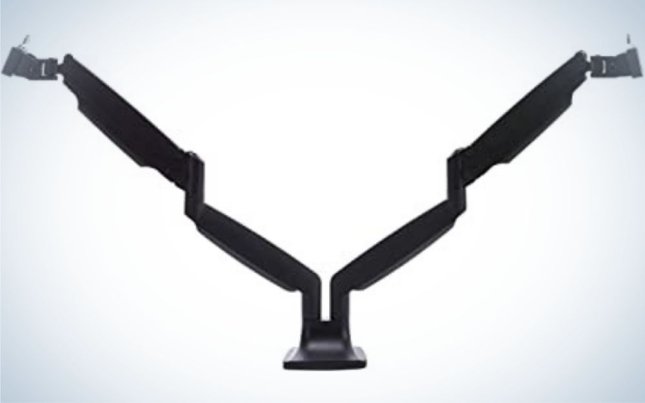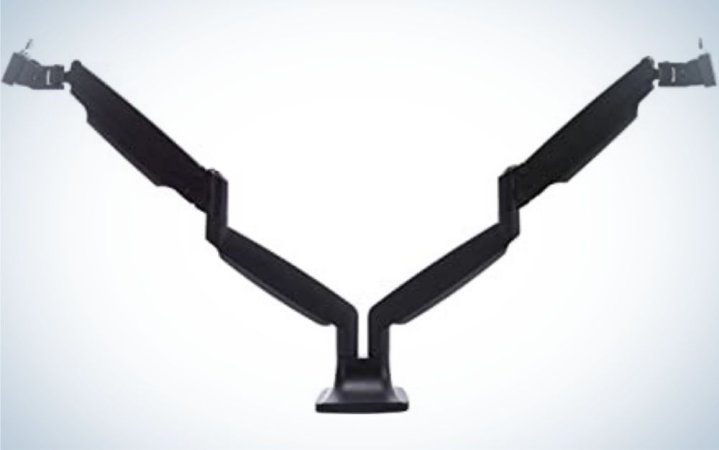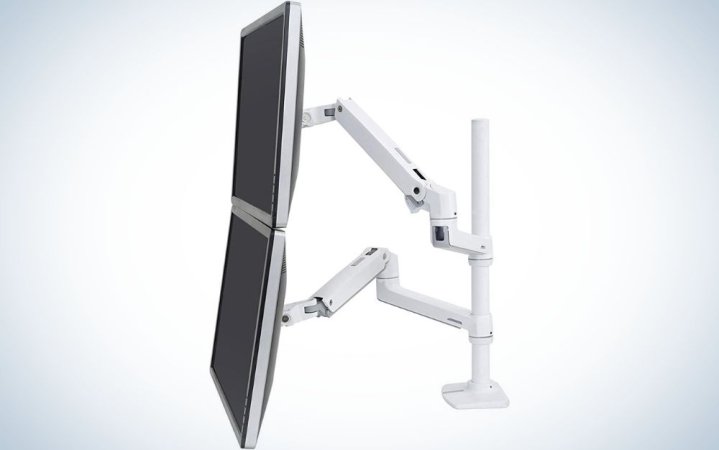We may earn revenue from the products available on this page and participate in affiliate programs. Learn more ›
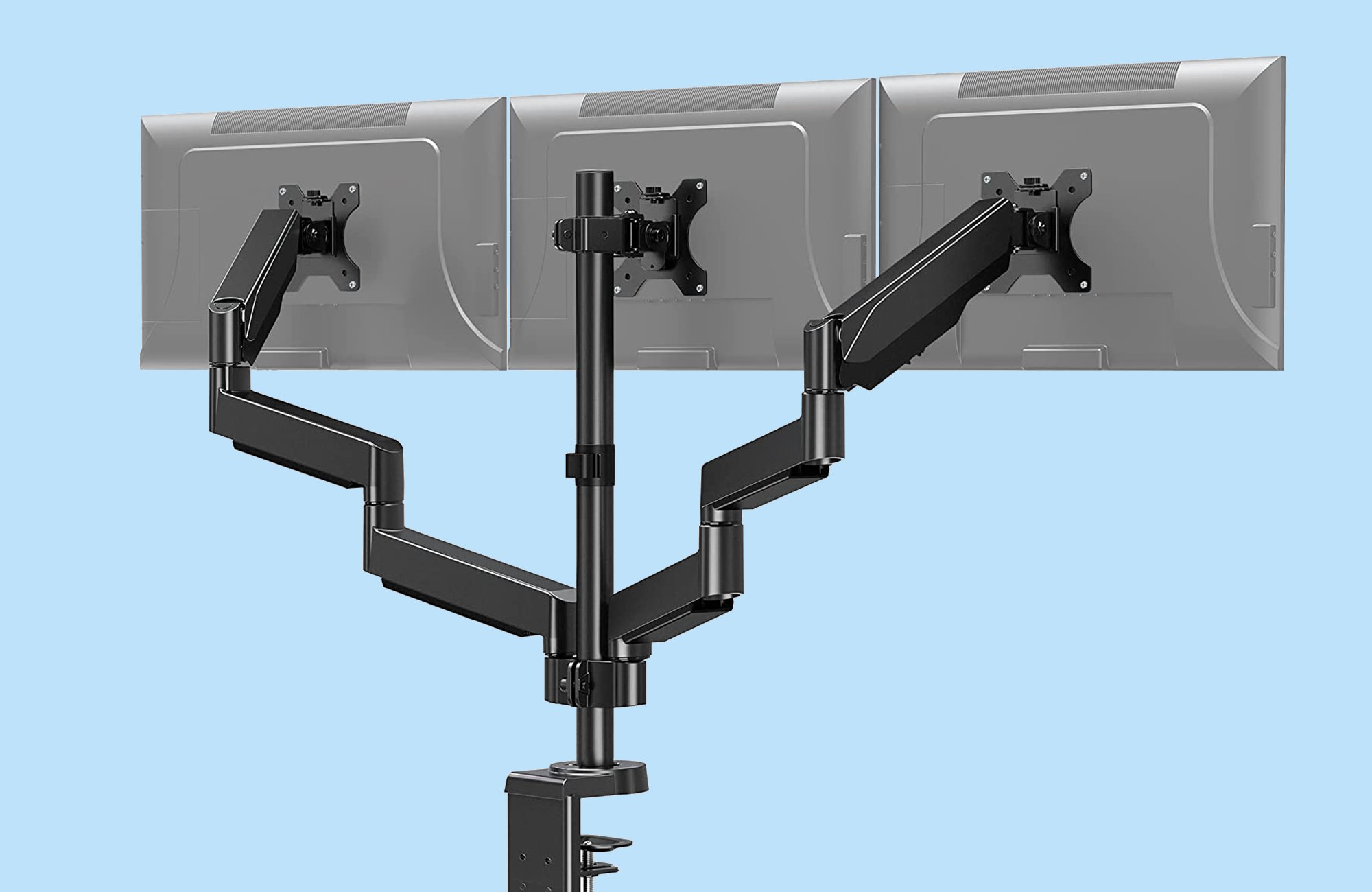
An ergonomic, efficient home office setup comes from many changes and tweaks, but there’s one accessory that makes an especially large difference: a monitor arm. Most monitors these days let you separate your display from its included stand and replace it with a flexible, movable arm that allows you to place the monitor at exactly the right height and angle for you. That said, a monitor arm is just a big hunk of plastic and metal, which means there are well-made ones and crappy ones. The best monitor arms feel durable, sturdy, and will make your home office so much better.
- Best single: Ergotron LX Single Monitor Arm
- Best dual: Workstream by Monoprice Dual Monitor Adjustable Gas-Spring Desk Mount
- Best triple: Mount Pro Triple Monitor Desk Mount
- Best stacking dual monitor arm: Ergotron LX Dual Stacking Arm
- Best ultrawide: Ergotron HX Desk Monitor Arm with HD Pivot
- Best budget: Monoprice 3-way Adjustable Tilting Monitor Desk Bracket
How we picked the best monitor arms
I’ve been working as a tech critic for almost 10 years and have tested monitor arms for The Tech Report, in addition to tinkering with them on my own time. In that time, I’ve used some of the best and worst options from different brands out there.
To make these selections, I drew upon my personal testing experience, spoke to both gamers and office workers, and aggregated professional reviews and online user impressions to find the best arms. Once you start digging, you’ll see that there’s an arm for virtually every use case you might need. We can’t cover every single scenario, however, so these picks focus on the most common needs, especially for people picking out an arm for the first time.
The best monitor arms: Reviews & Recommendations
There are a huge number of monitor arms and mounts out there, from replacement monitor stands to free-floating arms. They can hold anywhere from one to four displays, ranging in price points from $25 to well over $700. We can’t cover every use case here, so we’ve focused primarily on gas-spring mounts that you can position as you like, including options for single, dual, and triple-screen setups.
Best single: Ergotron LX Single Monitor Arm
Best single-monitor arm
Simple, Stylish, and Affordable
Pros
- Installation only requires a screwdriver and hex wrenches
- Built-in cable management
- 10-year warranty
Cons
- Expensive
Why it made the cut: The Ergotron LX Single Monitor Arm looks good, works well, and comes at a fair price.
Specs
- Mount type: Desk clamp or grommet hole
- Adjustment mechanism: Gas spring/Free moving
- Weight range: Up to 25 lbs
- Display size range: 13-32 inches
- Available colors: Black, Silver, White
- Price: $209
The Ergotron LX Single Monitor Arm monitor arm keeps it simple. One of the few monitor arms that sits in the space between “so cheap it’s suspect” and “so expensive it’s for business,” it offers tilt, swivel, height, and rotation adjustments, allowing you to position it just about anywhere you like.
Importantly, it offers toolless adjustment: Once you’ve calibrated the arm to support your monitor’s weight—a standard procedure with gas-spring monitor arms—you can move your monitor back and forward, up and down, and so forth without having to get out a hex wrench.
Best dual: Workstream by Monoprice Dual Monitor Adjustable Gas-Spring Desk Mount
Best dual-monitor arm
Do Dual Monitors Right
Pros
- Inexpensive
- Easy installation and adjustment
- Supports larger and heavier displays
- Lifetime warranty
Cons
- Independent adjustment
Buy it used or refurbished: eBay
Why it made the cut: Monoprice’s gas spring power dual-monitor arm offers great quality-of-life features at a fair price.
Specs
- Mount type: Desk clamp or grommet hole
- Adjustment mechanism: Gas spring/Free moving
- Weight range: Up to 19.8 lbs/arm
- Display size range: 15-34″
- Available colors: Black
- Price: $99
What doesn’t Monoprice make? One of the biggest names is computing accessories, Monoprice’s dual-monitor arm has most of the features you’d ask for when setting up a two-screen home office. It’s easy to install using hex wrenches that come in the box, and the mounts feature separate hardware to attach to your monitors to their brackets before snapping them into place on the arms. (We can’t overstate how much easier this makes installing and moving your setup.)
Like the Jarvis, Monoprice’s arm has cable channels to hide your display cables and keep things looking clean. Finally, the arms support monitors up to 34 inches and 19.8 lbs, so just about any display is going to fit on these, short of a super ultrawide display.
If you absolutely can’t stand the idea of having monitors of two different models side by side and want to have your displays perfectly aligned, you may want to go with something that locks the two displays at the same height to keep everything nice and uniform, like Monoprice’s Essential Dual Monitor Articulating Arm mount.
Best triple: Mount Pro Triple Monitor Desk Mount
Best triple-monitor arm
Three on One
Pros
- Separate mounting hardware
- Two fully adjustable arms
- Cable channels
Cons
- Limited adjustment of the central display
Buy it used or refurbished: eBay
Why it made the cut: With two adjustable arms and a stationary central pillar, Mount Pro’s triple-monitor arm offers a good combination of stability and flexible positioning.
Specs
- Mount type: Desk clamp or grommet hole
- Adjustment mechanism: Gas spring/Free moving
- Weight range: Up to 17.6 lbs/arm
- Display size range: 13-27″
- Available colors: Black
- Price: $119
When you need to truly multitask, using three monitors gives you a lot of screen space to work with. Things get a little more complicated when you try to mount more than two monitors, though: You’re asking the arms to support a lot more weight, which may or may not be positioned with balance in mind. A triple-monitor mount also just has a lot more in the way of moving parts. Mount Pro’s triple-monitor arm offers a good compromise of features and flexibility, with two free-moving gas-spring arms and one more static mount for the middle display. You can rotate all three of the monitors for vertical, horizontal, or mixed applications. The central arm helps ensure stability and makes that middle monitor a steady base to arrange your other screens around.
One small quibble: A 3-year warranty isn’t bad, but feels short compared to the warranties offered by Ergotron and Fully, especially on a three-screen arm.
Best stacking dual-monitor arm: Ergotron LX Dual Stacking Arm
Best stacking dual-monitor arm
Getting Down to Business.
Pros
- 15-year warranty
- Trusted name in the industry
- Flexible Options
Cons
- Very expensive
Buy it used or refurbished: eBay
Why it made the cut: The Ergotron LX Dual Stacking Arm is one of the only high-quality stacking monitor arms out there.
Specs
- Mount type: Desk
- Adjustment mechanism: Gas spring/Free moving
- Weight range: 14-40 lbs
- Display size range: Up to 24 inches
- Available colors: Black, white, silver
- Price: $409
There aren’t many stacking monitor arms out there, which let you mount two displays, one on top of the other. If you’re looking for one–this is what you want. The Ergotron LX Dual Stacking Arm offers tilting, panning, and rotation, as well as good cable management.
It’s worth noting that this is the only monitor on this list that doesn’t offer a quick-release/easy mounting option: You’ll have to hold the display up while you screw the arm onto the back of the display. Even so, this is about the best you’re going to get in this particular style.
Best ultrawide: Ergotron HX Desk Monitor Arm with HD Pivot
The ultrawide monitor arm
Ultrawide Safety Net
Pros
- Designed for super ultrawide monitors
- 15-year warranty
- Trusted brand
Cons
- It’s really expensive
Buy it used or refurbished: eBay
Why it made the cut: The Ergotron HX Desk Monitor Arm is made specifically to hold super ultrawide displays.
Specs
- Mount type: Desk
- Adjustment mechanism: Gas spring/Free moving
- Weight range: 28-42 lbs
- Display size range: Up to 49 inches/Super Ultrawide
- Available colors: White, Black
- Price: $405
If you’re going to spend $1,000 to $2,500 on an ultrawide monitor, you’d best make sure that the display is safe and secure. If you’re going to mount it on a monitor arm, you shouldn’t cut any corners or take any chances. The Ergotron HX Desk Monitor Arm is made specifically for large, heavy ultrawide monitors, so you know it’ll be solid. Plus, Ergotron has a convenient display finder on every product page where you can input your monitor make and model to make sure the mount in question is a good fit for your display. Treat your fancy toys with the respect they deserve and pair them with strong, reliable accessories.
Best budget: Monoprice 3-way Adjustable Tilting Monitor Desk Bracket
Best budget single-monitor arm
Solid and Secure

Pros
- 4-star rating after 392 reviews on Amazon
- Lifetime warranty
- Inexpensive
Cons
- Not as flexible as other options
Why it made the cut: The Monoprice 3-Way Adjustable Tilting Monitor Desk Bracket isn’t expensive and keeps your monitor on a swivel.
Specs
- Mount type: Desk
- Adjustment mechanism: Tool-assisted/Fixed
- Weight range: Up to 33 lbs
- Display size range: 13-30 inches
- Available colors: Black
- Price: $42
Monoprice’s budget monitor arm does the bare minimum but does it very well. For less than $40, though, that’s plenty. You can adjust the height and positioning of the display, but it’ll take time and a Phillips screwdriver to do so—it’s more of a process than many of our picks. Even with a more painful adjustment process, it still features a lot of crucial features, including mounting hardware, which takes a lot of the headache out of getting the display mounted.
Things to consider before buying the best monitor arms
Certain aspects of picking a monitor arm are streamlined—every monitor and monitor arm use the same standardized mounting measurements, for example, so you don’t need to think much about whether or not your monitor’s mounting bracket will fit in your arm. As simple as it is, there are plenty of things to keep in mind as you search for the right one. Before shopping around, you should figure out where you plan to mount the monitor arm, how many monitors you want to mount, and how you’d like to set them up.
The monitor arm is also one of those products where a manufacturer’s reputation counts for a lot. There are dozens of unknown brands out there, and you can always take your chances with one, but there are plenty of arms out there that will not be as sturdy or reliable as they claim. We’ve highlighted the most reputable, reliable gear to get your screens off your desk and perfectly positioned in front of your eyes.
Is your monitor compatible?
Most PC monitors are compatible with most monitor arms, but they aren’t universally interchangeable. First and foremost, some monitors cannot be removed from their stands. You’ll often find this on very low-end budget monitors, but it also happens on high-end displays every now and again. (Case in point, you can only mount the Apple Studio display if you buy it without a stand.)
To check your monitor’s mounting bracket, pull up the specs page for your monitor and look for information about VESA mounting compatibility. The VESA monitor mount standard, created by the Video Electronics Standards Association (VESA), features a metal plate with four screw holes that locks into place when inserted into a compatible mount. These mounts are used for monitors and TVs, so they come in a few sizes to carry monitors of different weights and sizes. Most monitors feature one of the two smallest sizes, 75mm x 75mm and 100mm x 100mm. More often than not, you’ll find a 100mm x 100mm bracket, which is rated to hold screens that weigh up to 30 pounds. You may find 75mm x 75mm on some very light 24-inch monitors, or 200mm x 100mm on 32-inch and/or ultrawide displays.
To give you an idea of how common each of these are, Newegg’s monitor database has over 1,000 displays that use the 100 mm mounting standard, about 550 that use the 75 mm standard, about 80 that do not offer mounting, and a few that use other mounting measurements. Make sure your monitor arm supports the brackets found on any monitors you plan to mount.
Desk mounting vs. wall mounting
Unlike a stand, you will need to install your monitor arm, either by fastening it to your desk with a built-in clamp, or installing a mount on your wall, like you would with a TV. There are different mounts for both styles, so you will need to plan your monitor placement before buying an arm.
Picking one option or the other comes down to personal preference, but we generally recommend a desk-mounted monitor arm over a wall-mounted one. They’re more affordable, easier to install, and more malleable if you want to move your office around. A wall-mounted monitor is a great option if you are sure your monitor is going to stay put for the foreseeable future and you have a solid plan for cable management, but it requires more work and planning.
Is your desk sturdy enough to support an arm?
If you plan to mount your monitor or monitors using a desk-mounted arm, you should make sure that your desk can carry that weight. As long as your desk surface is made of wood or metal, and is at least .75 inches thick, your desk should be able to support any arm and monitor(s) you attach. You should avoid clamping a monitor arm onto a glass desk. You should also keep in mind that the clamp may scuff up the far edge of your desk, so you may want to think twice before pairing one with an antique desk that you want to keep in pristine condition.
How many monitors are you mounting?
Different monitor arms are made to hold one, two, or three monitors. You can also get arms that arrange your monitors side by side or stacked vertically with one at eye level and one up high. If you have multiple displays, keep in mind that you don’t need to mount all of them. It may make sense to keep one monitor on its stand and put a second one on an arm to make it more adjustable.
Adjustment mechanisms
There are a few different kinds of adjustment mechanisms out there for arms. Some click into place when you move them. Other arms feature hinges that allow you to adjust horizontally or vertically. Top-of-the-line models feature a gas spring, which allows for smooth adjustments across a wide range of motion. A cheap stand may not let you adjust anything at all.
Aside from overall build quality, these mechanisms are what separate the good monitors from the bad, not to mention the cheap options from the expensive ones. The more often you plan to move the display around, the more you’ll want to spend on the arm.
Monitor arm weight limits
Every arm should list its maximum supported weight on its product page and include paperwork. While you have some wiggle room around monitor size, never install a monitor on an arm if it’s even an ounce (or gram) more than the listed limit. This goes double (or triple) when you’re mounting multiple displays.
FAQs
You should probably avoid clamping a desk-mounted arm on a glass desk. If you tighten it too much, a tempered glass desk surface could easily shatter from the pressure.
In theory, you could put a wooden or steel plate between the desk and the clamp to brace your desk, but chances are that an arm will put too much stress on a single area of your desk, causing it to crack or break. If you have a glass desk and want to mount your monitor, consider using a wall mount.
Monitor arms offer more adjustability and freedom of movement than the conventional monitor stand included in the box with your display. That said, you do not necessarily need to replace your monitor’s stand with an arm to create the perfect setup in your home office. If you own a high-end monitor, it probably comes with a high-quality stand that is both sturdy and features some amount of adjustability.
Monitor stands are not universal, but most stands should work with most monitors. Depending on the size and weight of the display, most 24-32-inch PC monitors support either 50 x 50mm or 100 x 100mm VESA mounting brackets. Most arms support one or both of those sizes as well.
Always check your display before making a purchase, but there’s a pretty good chance that you can pick and pair a random monitor with a random arm.
Final thoughts on the best monitor arms
- Best single: Ergotron LX Single Monitor Arm
- Best dual: Workstream by Monoprice Dual Monitor Adjustable Gas-Spring Desk Mount
- Best triple: Mount Pro Triple Monitor Desk Mount
- Best stacking dual monitor arm: Ergotron LX Dual Stacking Arm
- Best ultrawide: Ergotron HX Desk Monitor Arm with HD Pivot
- Best budget: Monoprice 3-way Adjustable Tilting Monitor Desk Bracket
There are a lot of monitor arms out there. When you pick yours, you’ll have to decide how much you’re willing to pay and how much adjustability you really need. We’ve focused primarily on desk-mounted, free-floating gas-spring displays here, since improved adjustability is a big part of what makes using monitor arms great. These are our favorites, but we can’t possibly cover every use case in one piece.
